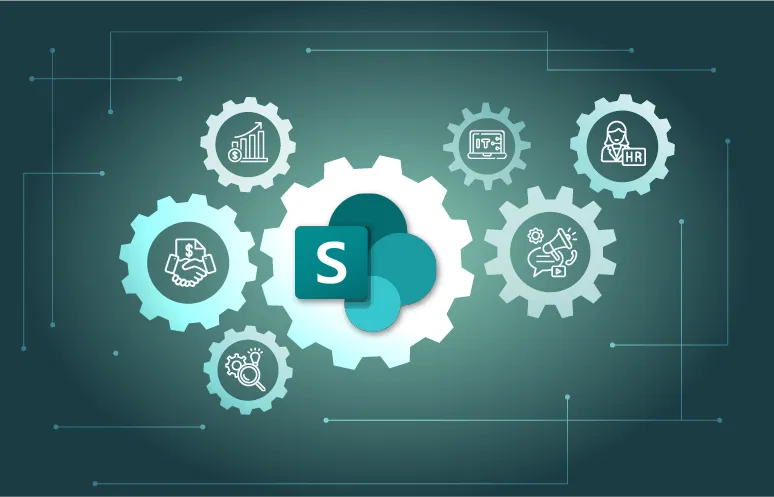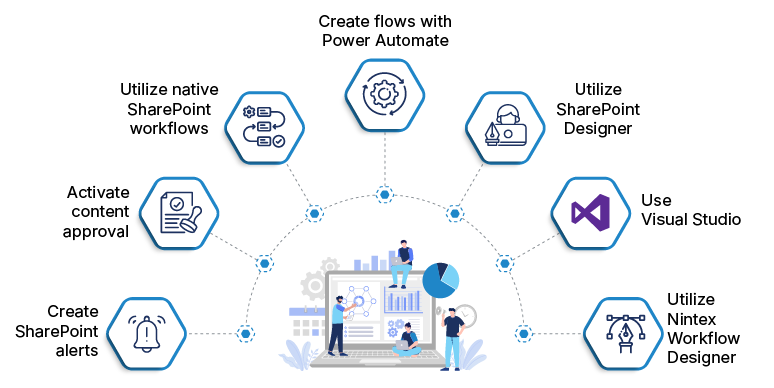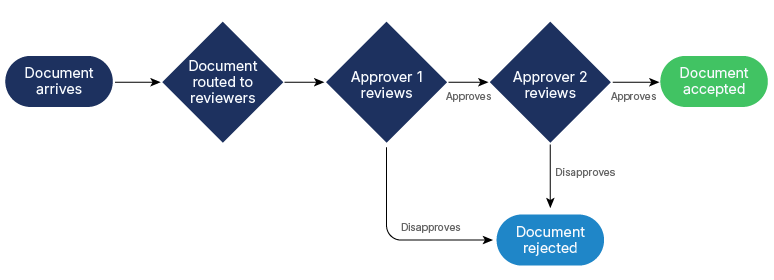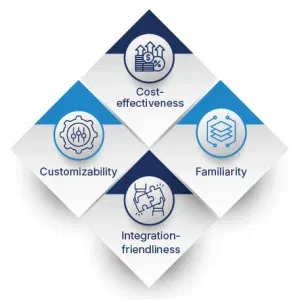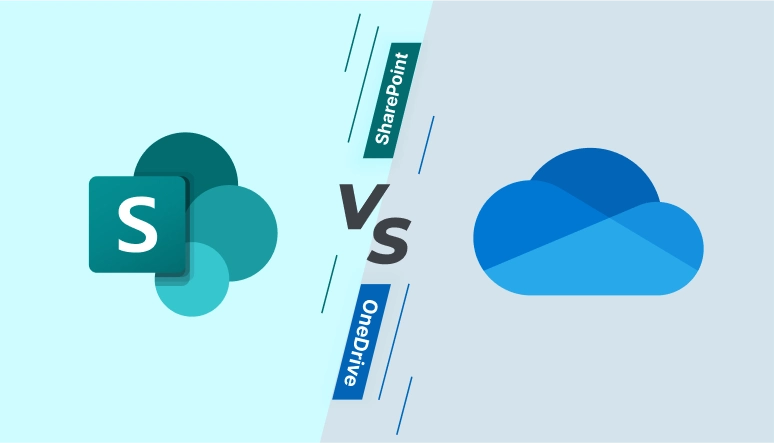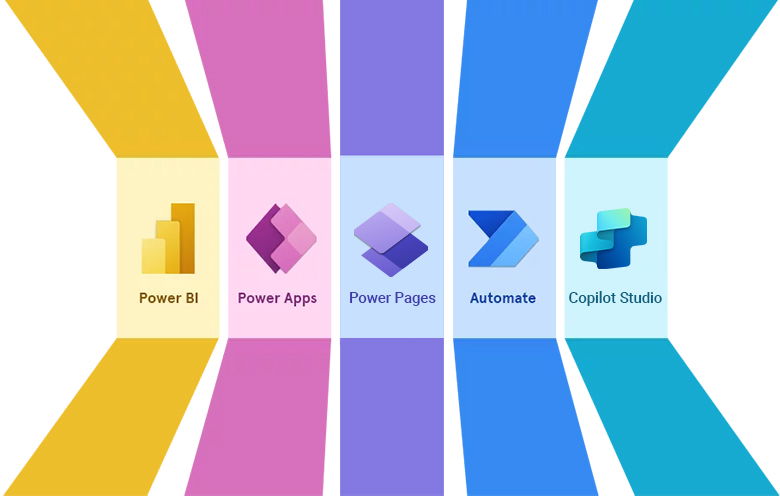Every business includes administrative tasks that require significant time and attention every day. For instance, approving documents, updating records, sending reminders, taking follow-ups, etc. Individually, they may seem minor tasks, but collectively, they can significantly slow down your team and drain productivity.
That’s where SharePoint automation can make a real difference. With SharePoint workflow automation and tools like Power Automate, you can turn these repetitive tasks into smooth, self-running processes.
From managing documents to keeping data organized and communication on track, automation in SharePoint helps you work smarter. In this blog, we’ll look at how SharePoint business process automation works, what you can automate, and why it could be exactly what your business needs to move faster and stay ahead.
What is business process automation?
Business process automation is the use of technology to assist companies in enhancing efficiency. It enables teams to utilize technology like software applications to simplify their repetitive tasks or processes carried out on a regular basis. Automation of routine processes removes manual efforts while lowering costs, improving efficiency, and speeding up processes.
Why does your business need SharePoint automation?
As your business expands, efficiency depends on how well you can automate routine work. SharePoint automation helps you scale without extensive manual work by creating workflows that run in the background and keep operations seamless. It’s about aligning your processes with a system that’s built for growth.
5 indications that prove your business needs SharePoint automation workflows:
- Your enterprise deals with numerous repetitive tasks.
- These tasks require many people for accomplishment.
- Your team works on tight schedules.
- These activities impact other organizational systems and processes.
- Your work include compliance and audit trails.
These signs may seem routine, but together they can hold a business back in a big way:
According to the International Data Corporation (IDC), businesses lose 20–30% of their revenue every year due to inefficiencies.
How to use SharePoint for business process automation?
SharePoint business process automation helps you turn inefficiencies into opportunities for growth. When you map out where delays or bottlenecks occur, SharePoint gives you the tools to turn those into automated workflows. The key is to focus on creating processes that add value without adding complexity.
-
Create SharePoint alerts
SharePoint alerts notify you whenever a file, folder, or list item is added, updated, or deleted. Alert creation informs users about changes made in their Microsoft SharePoint items or documents on their website. You can easily set up alerts for a list, library, folder, file, or list item.
You can also create it on a particular library folder to get an alert only when there are any changes made on any file within that folder.
-
Activate content approval
With Power Automate, you can activate the content approval functionality in SharePoint libraries for documents that have sensitive data. You can easily place an approval process for documents within the document library where you need approval of documents.
With this content approval process, the documents awaiting approval will not be accessible to users until they are approved.
-
Utilize native SharePoint workflows
SharePoint has built-in workflows to handle common challenges that your company may have such as approvals, comments, electronic signatures, task management with stages, and publishing of content.
Monitoring and tracking work such as sending documents and reminders requires additional effort because it brings never-ending disruptions. SharePoint includes pre-configured workflow templates that allow you to automate work, like obtaining signatures or requesting approval of a document. This removes the hassle of performing these repetitive processes manually.
For instance, while working on documents, you can utilize the SharePoint document approval workflow to execute the process for verification and monitoring. The workflow automatically handles reminders and forwarding.
-
Create flows with Power Automate
With Power Automate, you can create workflows for lists and libraries in your Microsoft Lists, SharePoint, and OneDrive. Flows are a time-saver and effort-reducer that help bring efficiency and consistency to your repetitive tasks.
Power Automate also assists you in automating routine tasks between SharePoint, other Microsoft 365 services, and third-party services.
Functions that can be automated with SharePoint through Power Automate
Power Automate acts as the bridge that connects SharePoint to a wider ecosystem. It allows businesses to move beyond file storage and sharing, enabling complete workflow automation. The real value lies in picking the right functions to automate first.
| Functions | Outcome |
|---|---|
| Automate data extraction | Verification and population of data from spreadsheets, PDFs, or other documents. This speeds up the process to pull, verify, and create report on data. |
| Automate document processing | Select information from forms, PDFs, images, emails, and other data sources. It enables you to create or distribute documents easily and quickly. |
| Automate workflows | Automate processes that have a certain sequence of activities. For example, checking inventory, ordering, invoicing, reporting customers, etc. |
| Automate the stream of important information | Saving, organizing, and sharing your valuable documents and business information is essential. Using infinite connectors and plugins in SharePoint, you can simplify fetching email attachments, tweets, tasks, and more. |
| Automate manual and third-party processes | Your company may be employing some extra steps to authenticate user information, sales data, or other critical pieces of information of your work. You can take advantage of a vast collection of tools and connectors in SharePoint that can eliminate these additional efforts entirely. |
| Automate routine work activities and steps on your projects | Automate a sequence of several tasks which can be done within minutes rather than hours by automating activities such as sending an email, adding a task on your planner, and sending a message to your team and more. |
-
Utilize SharePoint Designer
Designing workflows with SharePoint Designer is an effective way to manage business processes in your company, from simple approvals to complex multi-step workflows. You can automate business application processes as well as human collaborative processes using SharePoint designer.
A business application workflow allows updates in a single data source immediately after a change occurs in another data source. On the other hand, human collaborative process workflows allow users to submit a document to an employee’s manager for authorization.
-
Use Visual Studio
Visual Studio provides another effective form of workflow known as the state machine workflow. This helps to model your workflow in an event-driven fashion. While creating workflows with Visual Studio requires technical skill, it has multiple features that help in developing advanced workflows.
These features provide immense flexibility and customization to developers in order to design workflows that enable more than a single business process. Another benefit of creating workflows with Visual Studio for SharePoint is that you can develop some useful templates and deploy them to several SharePoint sites.
-
Utilize Nintex Workflow Designer
If SharePoint Designer or Visual Studio workflows don’t meet your needs, third-party tools like Nintex offer advanced options to build custom workflows and extend automation capabilities.
These workflows seamlessly integrate with SharePoint allowing IT managers to enhance the functionality of their SharePoint experience and enhance the business value of their workflows.
What can be automated in SharePoint?
The scope of automation in SharePoint is quite flexible. The best place to start is where your team feels the most friction. Those pain points often turn out to be the best places to introduce automation. Automating them can create quick wins that prove the impact of SharePoint workflow automation.
A Gartner survey reveals 80% of executives think automation can be applied to any business decision.
-
Document approval processes:
Automate the routing of files to the correct approvers by document type, author, or content. Create multi-stage approval chains where various stakeholders approve documents sequentially with automated escalation if approvals are late.
-
Automation of HR processes:
Automate leave requests from submission to approval. Send alert to the HR department automatically about upcoming leaves. Automate new hire onboarding workflows that create accounts, distribute equipment, and plan orientation sessions.
-
Document organization and routing:
Send files to folders or libraries by metadata, document type, or business rules. Automatically archive obsolete documents and maintain version control in your document repositories.
-
Task creation and management:
Automatically create tasks and subtasks when new items are added to lists or project status change. Allocate work to team members based on workload, skill, or availability.
-
List and library operations:
Automatically update, delete, or change fields in list items and documents. Perform bulk operations on multiple items based on certain criteria or fixed intervals.
-
Reminders and notifications:
Send reminders via Teams, Outlook, or SharePoint when deadlines draw near, task status changes, or new documents are uploaded. Establish escalation routes for late items.
-
Automation of financial processes:
Process budget approvals, invoice processing, and purchase order workflows that involve multiple approval steps and stakeholder alerts.
-
Data handling and form processing:
Process data gathered via Power Apps forms, automatically update databases, and forward responses to relevant departments or personnels.
Benefits of SharePoint automation
SharePoint creates long-term stability. When processes run automatically, your business gains consistency, compliance, and confidence. This foundation makes it easier to grow without being slowed down by inefficiencies.
-
Cost-effectiveness
SharePoint offers a minimal license price. This makes SharePoint cost-effective even for a small corporation. Furthermore, if businesses don’t need cumbersome workflows to track inventory or support compliance, SharePoint out-of-the-box workflows can easily meet their requirements. For businesses already invested in SharePoint, the cost-efficiency of building business process automation becomes even more evident.
-
Familiarity
User adoption concerns are minimized since the employees are already familiar with the platform. For instance, many organizations already use SharePoint as a corporate intranet for communication and collaboration. This can also minimize training time for employees to use automated workflows, and they can benefit from a solution faster.
-
Integration-friendliness
SharePoint natively integrates with Office 365 tools. This enables document creation directly in SharePoint, which helps to initiate document-related workflows. Furthermore, SharePoint provides integration with enterprise systems, which helps create cross-company workflows and offers visibility into a company’s digital world.
-
Customizability
SharePoint provides a high level of customizability. This makes it suitable to automate processes applicable to all sectors such as onboarding, document approval, feedback, reporting, training, asset management, accounting, purchasing approval, leave approval, and help desk request. And it can also automate sector-specific functions, like:
| Industry | Functions |
|---|---|
| Healthcare | Patient data management, patient billing, records management, compliance reporting, medical inventory and transportation management, incident management, and insurance authorization approvals. |
| Manufacturing | Warehouse and procurement operations, quality assurance, product shipment and delivery, repair orders, and site examination. |
| Banking | Loan applications, automated credit and money transfer, interfacing with other Automated Bank Systems (ABS), and budgeting. |
| Law | Case management, retainer agreement management, call and meeting scheduling |
Start automating, start growing
The early your business embraces SharePoint automation, the sooner you can shift your focus from managing processes to driving results. Instead of letting valuable hours get consumed by repetitive tasks, automation in SharePoint enables your teams to focus on innovation, strategy, and growth.
Over 2 billion automated workflows, ranging from simple document approvals to complex multi-step business processes are orchestrated on SharePoint every day, demonstrating the extensive reliance on automation to handle repetitive workloads.
-Microsoft
By leveraging SharePoint workflow automation and Power Automate SharePoint integration, you create a connected ecosystem where data flows seamlessly, decisions are made faster, and work gets done without constant manual intervention. Now is the right time to take a closer look at your operations and identify where automation can make the biggest impact. Collaborate with a Microsoft 365 consulting service provider to eliminate inefficiencies and achieve the full potential of your business processes with SharePoint business process automation.
